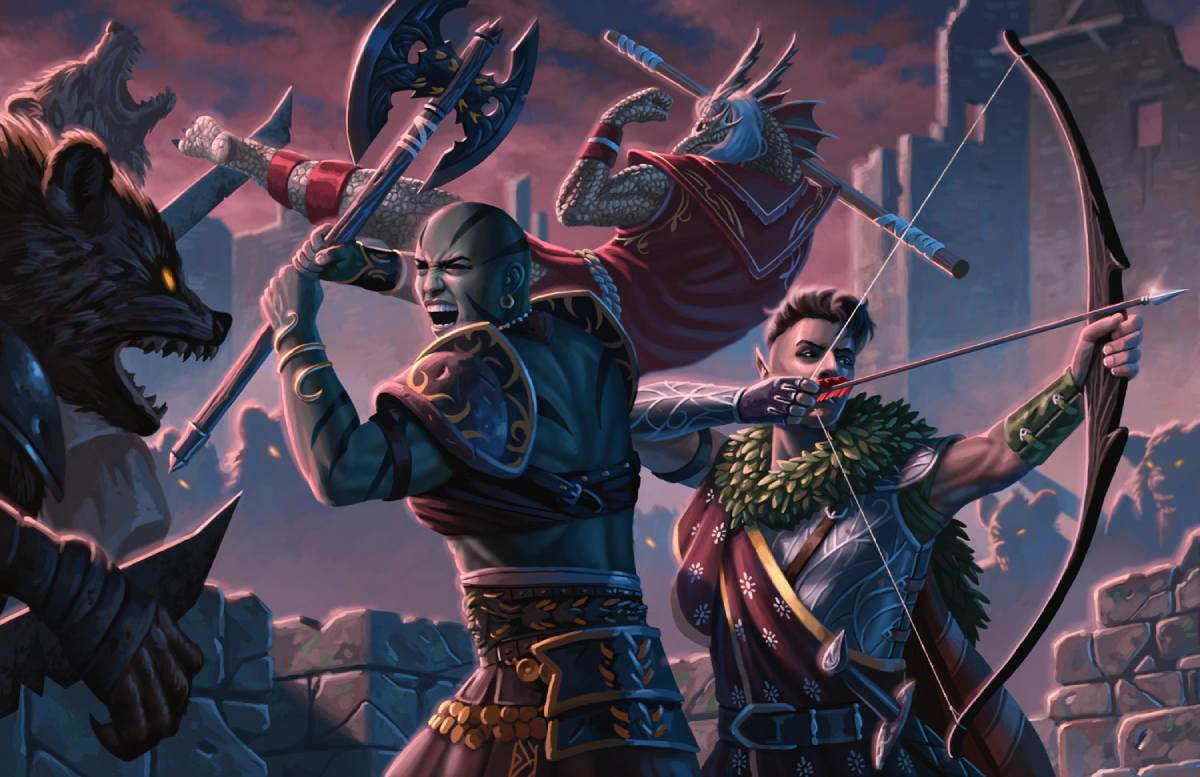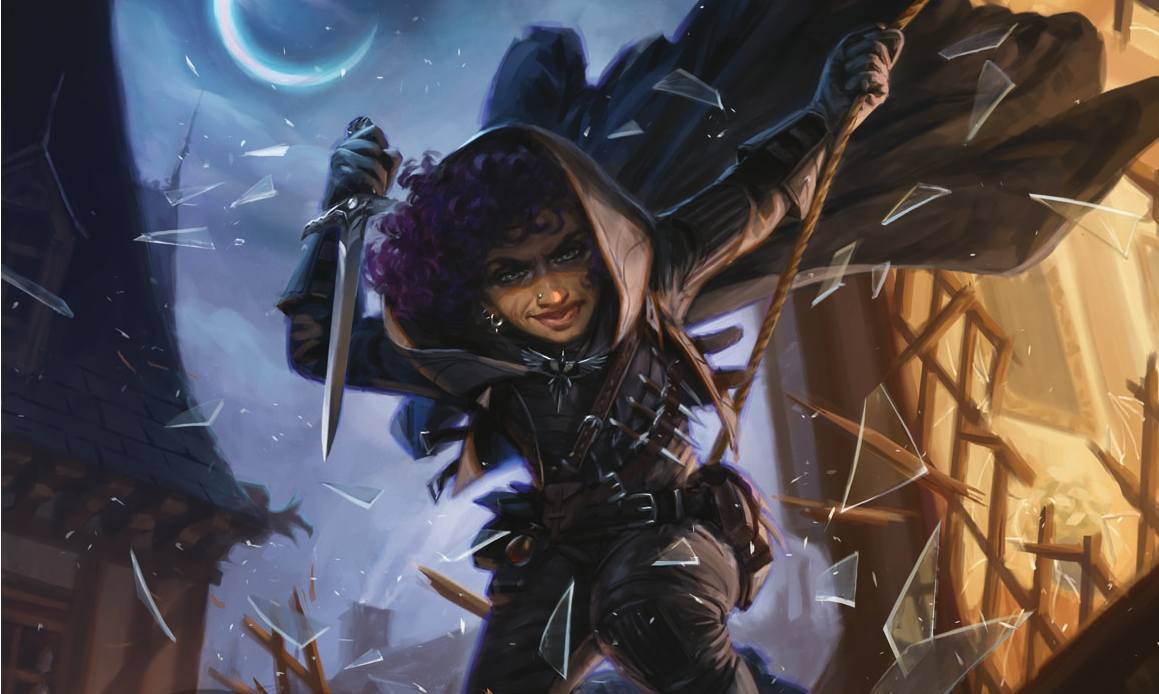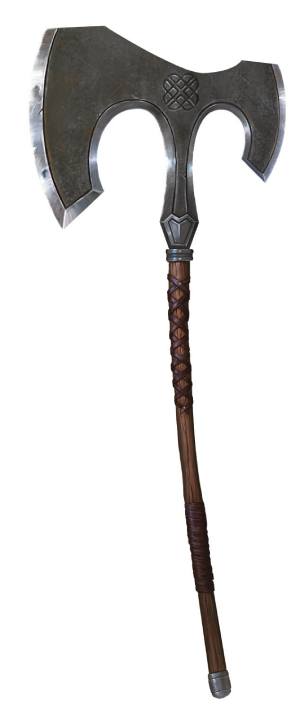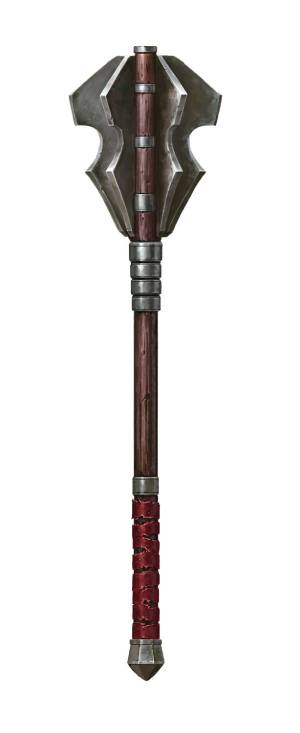The Fighter uses their Maul to knock down their opponent, the Rogue dances around with their Rapier to find their foe’s weak point, and the Barbarian swings a Greataxe through two enemies with a single blow. Every character in D&D has a unique flare they bring to combat, and that’s reflected in the new Weapon Mastery feature in the Player’s Handbook!
Let’s explore these fresh ways to utilize your weapons in the upcoming core rulebook revamp!
Build Your Warrior Today
Start building your weapon-wielding warrior today in D&D Beyond's Character Builder. You can access Weapon Mastery for free using the D&D Beyond Basic Rules, so you can test out this new brand-new system and start cutting a heroic path through your foes!
What is Weapon Mastery?

Weapon Mastery is a class feature shared between some martial classes that reflects their specialization with certain types of weapons.
Each weapon in the Equipment section of the 2024 Player’s Handbook lists a mastery property in addition to the weapon’s regular properties. If the weapon meets the requirements in your class's Weapon Mastery feature, you can learn its mastery property and use it in combat.
But learning a mastery property isn't permanent. If you stumble across a shiny new +1 Longsword and want to learn its mastery properties instead, don’t worry! During a Long Rest, you can practice weapon drills and swap out one of your weapon choices at the end of the rest.
The number of mastery properties you can learn is specified in your class's version of the Weapon Mastery feature. Rogues, rangers, and paladins can only access two mastery properties at a time, whereas barbarians and fighters start with two and three, respectively, and eventually gain access to more mastery properties, as detailed in their Features table.
At level 1, Barbarians, Fighters, Paladins, Rangers, and Rogues get access to the mastery properties for certain types of weapons, as listed below:
- Barbarian: Simple and Martial Melee weapons
- Fighter: Simple and Martial weapons
- Paladin: Based on weapon proficiencies (Simple and Martial weapons)
- Ranger: Based on weapon proficiencies (Simple and Martial weapons)
- Rogue: Based on weapon proficiencies (Simple weapons and Martial weapons with the Finesse or Light property)
Mastering Weapon Mastery
Some subclasses allow you to access more mastery properties. For example, the Soulknife Rogue can use the Vex mastery property with their Psychic Blades and it doesn’t count toward their learned Weapon Mastery limit.
How to Use Weapon Mastery Properties
If you’re wielding a weapon and have learned its mastery property, you’ll be able to use that mastery property every turn when you make an attack with the weapon.
Different mastery properties have different triggers. For example, Cleave requires you to hit a creature with a melee attack roll while Graze triggers when you miss a creature with an attack roll.
Unlike some abilities, there’s no limit to how many times mastery properties can be used per Short or Long Rest, so go nuts!
Mastery Properties Overview

Below, we’ll cover each of the eight mastery properties included in the 2024 Player’s Handbook. We’ll even throw in some tips to help you brainstorm ideas for your new characters!
Cleave

Example Weapon: Greataxe
If you’ll be wading into the thick of battle, you’ll want to consider grabbing a weapon with the Cleave property.
These heavy weapons can slash through opponents. If you hit a creature with a melee weapon attack, you can make a second attack against a creature within 5 feet that is also within your reach. When you hit with the second attack, you can roll your weapon’s damage, but you don’t add your ability modifier unless it’s negative.
This is excellent in combination with the Halberd, which has Reach and Cleave, allowing you to Cleave into enemies in an extended range.
Graze
Example Weapon: Greatsword
Graze is an excellent way to increase the consistency of your weapon damage.
If you miss a creature with your weapon, you deal damage equal to the ability modifier you used to make the roll. This pairs well with abilities that allow you to make a lot of attacks, like the Fighter’s Extra Attacks features or the Polearm Master or Sentinel feats.
It just goes to show that when a weapon is big enough, you don't really need to aim where you're swinging.
Nick
Example Weapon: Dagger
To explain the Nick property, we should briefly cover that being able to attack twice while dual-wielding Light weapons has subtly changed in the 2024 Player’s Handbook. Instead of being covered under Melee Attacks, the rules for dual-wielding Light weapons are covered under the Light weapon property.
It still functions the same way: When you make an attack with a weapon that has the Light property, you can use a Bonus Action to make one attack with a different Light weapon you’re wielding.
The Nick mastery property allows you to make the additional attack you receive from wielding two Light weapons as part of the initial attack action.
Keep in mind that this doesn’t mean you can make a third attack as a Bonus Action, as the Light property specifies you only get one extra attack. But, while it may not pump your damage, this frees up your Bonus Action to use class/species abilities, such as the Rogue’s Cunning Action, while still getting an additional attack in.
Push
Example Weapon: Greatclub
Sometimes giving an enemy a simple shove off a cliff or into a pit of lava is all you need to win an otherwise tough encounter! The Push mastery property allows you to launch a creature you hit 10 feet straight away from you without a save.
Not only is this great when combined with environmental hazards, it's also great for escaping Opportunity Attacks. If you or a less tanky party member are being harassed by an enemy, you can push the enemy 10 feet away, which can allow you to create the space needed to escape unscathed.
Keep in mind that you can only push enemies Large or smaller, so don’t go getting stuck next to an Adult Black Dragon.
Sap

Example Weapon: Mace
If your job is to distract the enemies for long enough to let your blaster caster friends deal with them, Sap is a solid choice.
When you hit an enemy with an attack, this mastery property inflicts Disadvantage on your target’s next attack roll before the start of your next turn.
So, for heavily armored, tanky builds, your enemies will be so focused on trying to take you out that they won’t even see the Fireball coming.
Slow
Example Weapon: Light Crossbow
This mastery property is excellent for fast builds that like to flit across the battlefield. When you hit a creature and deal damage, you can reduce its Speed by 10 feet until the start of your next turn.
This combos excellently with the Light Crossbow, allowing you to take shots, damage your opponents, and then move to just out of range of their reduced Speed. Rinse and repeat until they look like a pin cushion.
It’s important to note that a creature hit more than once by weapons with this property doesn't have its Speed reduced any more than 10 feet. So don’t expect to stand still, hit your enemy three times, and not get caught.
Topple
Example Weapon: Maul
This mastery property is for all those builds that love to wail on their enemies with multiple melee attacks.
When you hit a creature, you can force it to make a Constitution saving throw or fall Prone. The DC for this save is 8 plus the ability modifier used to make the attack plus your Proficiency Bonus.
So, a level 5 Fighter with a Maul could knock their opponent Prone with their first attack, then use their second attack and Action Surge to make multiple attacks with Advantage.
Just remember attacking Prone enemies outside of 5 feet actually gives the attacker Disadvantage on their attack roll. So only use this ability if you or another melee-minded party member can take advantage of it.
Vex
Example Weapon: Shortsword
Having a weapon with Vex feels like a superior swordsman dancing around their opponent, striking at openings until the battle is won.
When you hit a creature and deal damage, this mastery property gives you Advantage on your next attack roll before the end of your next turn. This is an excellent way for Rogues to all but guarantee a Sneak Attack hit on their next turn.
The Student Becomes the Master
The 2024 Player’s Handbook is now available on the D&D Beyond marketplace, which means it's time to set out on new adventures with fresh or familiar characters!
Weapon Mastery is a fun way to give martial characters more choice in combat. It also revamps the way weapons feel in D&D. The new options and revisions presented in this book are a result of a decade of lessons learned and adventures had. With updated rules and streamlined gameplay, it's never been easier to bring your stories to life.
We’re delighted to share with you the changes to fifth edition D&D that appear in the 2024 Player’s Handbook. Make sure to keep an eye out on D&D Beyond for more useful guides on using the wealth of new options, rules, and mechanics found in the 2024 Player's Handbook!

Mike Bernier (@arcane_eye) is the founder of Arcane Eye, a site focused on providing useful tips and tricks to all those involved in the world of D&D. Outside of writing for Arcane Eye, Mike spends most of his time playing games, hiking with his partner, and tending the veritable jungle of houseplants that have invaded his house.
This article was updated on August 12, 2024, to issue corrections or expand coverage for the following features:
- What is Weapon Mastery?: Made clear that the Rogue is proficient with all Simple weapons.
- Slow: Clarified that the Slow property doesn't stack with itself.








-
View User Profile
-
Send Message
Posted Jun 19, 2024I notice that flex is gone. I hope this means that depending on one handed or two handed change the mastery, but I’m guessing they just have one
-
View User Profile
-
Send Message
Posted Jun 19, 2024Versatile weapons have the same mastery regardless of how they're wielded. Flex is gone because it didn't really do anything interesting or impactful.
-
View User Profile
-
Send Message
Posted Jun 20, 2024my question is do these stack? for example a Rogue using a dagger with nick. Could they have a shortsword in the offhand and guarantee sneak attack on the next turn thus infinite loop of sneak attack? This feels kinda broken if sneak attack wasn't already. This is still early days and I hope a ruling comes out in the book or soon after as this could be MTG levels of one table does this the other that.
Edit: reading some comments im not the first. As A DM id rule one mastery per character turn(or main hand only) but others might allow it. As a player it does lean into the swashbuckler Rogue and allows for more diverse builds that don't rely on stealth all that much while still using the class feature.
-
View User Profile
-
Send Message
Posted Jun 20, 2024It's not infinite, because at some point that enemy is going to die and your Vex will need to be restarted due to needing to switch targets. Also, Rogues can get advantage every single round without Vex anyway thanks to Steady Aim, and that's under the current rules. It's not a big deal.
Also - a rogue who is spending their two masteries on a Nick dagger+Vex shortsword is not benefiting from any Mastery on their bow, so there's a tradeoff there.
-
View User Profile
-
Send Message
Posted Jun 20, 2024I MUST know what the longsword property is. Please be extra defence when wielding with two hands, my longsword obsessed knight NEEDS it now!
-
View User Profile
-
Send Message
Posted Jun 20, 2024Per the most recent playtest, longswords have the Sap property (target gets disadvantage on their next attack if you hit, no save) making longswords a good tanking choice for your sword and board character, e.g. a Paladin. In fact, at low levels when your enemy only has one attack, you can wield them two-handed for the extra damage from Versatile and still have solid defense since the enemy will have disadvantage.
-
View User Profile
-
Send Message
Posted Jun 20, 2024Don't worry, they will come out with all sorts of new shit to add and create D&D "Two". Its about revenue, not the game anymore.
-
View User Profile
-
Send Message
Posted Jun 20, 2024The description of Cleave is a bit confusing, it specifies 'within 5 feet', but then goes on to say a Reach weapon can cleave for extra range. Should it not be written as "the weapon's range" instead of "5 feet"?
"These heavy weapons can slash through opponents. If you hit a creature with a melee weapon attack, you can make a second attack against a creature within 5 feet that is also within your reach. When you hit with the second attack, you can roll your weapon’s damage, but you don’t add your ability modifier unless it’s negative.
This is excellent in combination with the Halberd, which has Reach and Cleave, allowing you to Cleave into enemies in an extended range."
-
View User Profile
-
Send Message
Posted Jun 20, 2024Damn those designers, wanting to get PAID and stuff. They should make the game for free!
What the wording means is that the two enemies have to be within 5ft of each other - they don't have to be within 5ft of you (if your reach with that weapon is greater than 5ft.)
-
View User Profile
-
Send Message
Posted Jun 20, 2024OH MY LAWD! No more eating up my bonus action for advantage so I can actually keep mobile.
"Soulknife Rogue can use the Vex mastery property with their Psychic Blades"
"Vex: When you hit a creature and deal damage, this mastery property gives you Advantage on your next attack roll before the end of your next turn. This is an excellent way for Rogues to all but guarantee a Sneak Attack hit on their next turn."
-
View User Profile
-
Send Message
Posted Jun 20, 2024No. It's one or the other.
-
View User Profile
-
Send Message
Posted Jun 20, 2024We had weapon stuff before in 2nd ed and in 3rd edition.
What old is new again.
-
View User Profile
-
Send Message
Posted Jun 20, 2024I was thinking the same thing lol
-
View User Profile
-
Send Message
Posted Jun 20, 2024I'm actually kind of shocked at how good this seems. (Sorry though, it's not enough to make me give WotC any more $$$.)
-
View User Profile
-
Send Message
Posted Jun 20, 2024This would have made more sense, as it combos with enlargement features/spells.
-
View User Profile
-
Send Message
Posted Jun 20, 2024The problem is that Push is stronger than Shoving because you also get weapon damage (and on-hit effects like poison or Crusher) every time. With shoving you have to give up your damage, so Push would be strictly better without the size cap.
-
View User Profile
-
Send Message
Posted Jun 20, 2024Whoops, missed that in the playtest. Glad they dropped flex.
So I'm looking at the two handed weapons and wondering are these balanced against each other, as in, would a martial character feel like there is a legitimate reason to choose one two handed weapon over another
It does seem overall that the versatile weapons have a better mastery property, which would give two handed weapon fighters a reason to use them.
-
View User Profile
-
Send Message
Posted Jun 20, 2024A lvl 20 fighter with Belt of Storm Giant Strength will do 36 points of damage even if they miss every time with Graze
A Tarrasque (676 hp) could be killed by a single fighter in 19 rounds. Seems a bit OP to me.
Also Graze seems to work with a roll of 1 on a d20.
-
View User Profile
-
Send Message
Posted Jun 20, 2024I'm the only one here thinking that, while this look in paper an awesome way to give more variety to martials, this is actualy going to end up with the player having a single weapon type of choice and continuously repeat the same tactic again and again and again ad nauseam?
I would rather prefer to have a limited number of uses, like BG3, and maybe make these masteries more powerful to balance that limitation.
Dunno, I'm not that knowledgeable about the changes in this "new" edition, but this seems like a "let's buff this so nobody can say that martials aren't better now!" in a somewhat simplistic way.
-
View User Profile
-
Send Message
Posted Jun 20, 2024Damn, trying to sell me a product but you have the sentence "it still functions the same way" tells me the 2024 books are a clear rip off of my money.